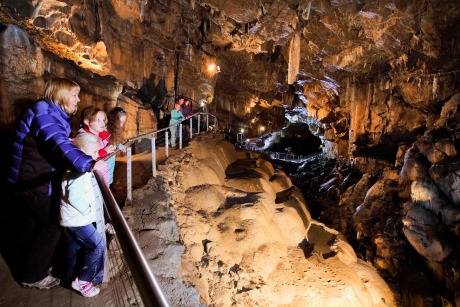
Poole’s Cavern offers a cross curricular experience for all ages with activities both below and above ground. STO takes a closer look at what exactly is on offer at the limestone caverns hidden beneath the Peak District.
Geography, History and Science are amongst the choice of subjects that can be tied in during a school trip.
What can students do on a visit?
A standard educational visit to Poole’s Cavern includes a cavern tour which fits in with both Key Stage 1 and Key Stage 2 studies.
The cavern journey takes around one hour and has a number of links to History. The tour takes in the Roman chamber archaeological dig, where students will learn about how the caverns were used from the Stone Age, through to Roman explorers and Medieval robbers.
The tour also includes a visit to the Limestone cavern formation, where the subjects of water cycle, fossils, rocks, soils and crystal formations will be visited; ideal for Geography students. Other topics that can be covered include caves, environments, materials and properties, life processes, rivers, light, habitats, rocks and soils and the water cycle.
This area also offers the chance to search for faces and shapes within the cavern, and it is here that additional resources and worksheets, provided by Poole’s Cavern, can be used.
What are the additional resources?
Teachers can use provided worksheets to support National Curriculum links.
A Geography worksheet, for example, will encourage the students to observe, record, identify and describe what the cavern is like.
A Science worksheet, meanwhile, focuses on life processes and living things. Pupils will learn the differences between things that are living and things that have never been alive, and also discover the senses that enable humans and other animals to be aware of the world around them.
Other examples include resources that link to materials and their properties, and physical properties, like light sources.
Follow up worksheets for learning on return to school are also available.
Extended visit
Schools can spend the morning at Poole’s Cavern, break for lunch and then go on to spend the afternoon at Buxton Country Park Woodland.
The 100 acres of woodland can be made use of on a teacher-led trails to Solomon’s Temple viewpoint overlooking Buxton with interpretation panels, or schools can book sessions with an ‘Outdoor Genius’ for organised outdoor activities.
All visits can be linked to the National Curriculum through a workshop that lasts around two hours. Examples include Fire Starters, Fossil Hunters and Temple Hunters sessions.
The Fossil Hunters workshop, for example, is designed to link in with rocks and soils topics, and sees schools investigating what lies beneath trees. Pupils will learn what was at the site millions of years ago and will be able to spot different types of fossils on their journey throughout the woods. They will also discover why limestone is such a valuable commodity.
Further information
Teachers can visit the website for free teacher’s resource notes, risk assessments and accompanying worksheets.
Bespoke learning experiences can also be arranged to suit specific National Curriculum requirements.
For more information visit www.poolescavern.co.uk.










